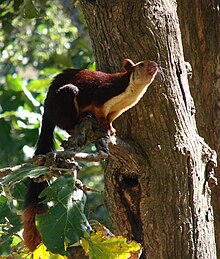| Oriental giant squirrels Temporal range: Middle Miocene to Recent
| |
|---|---|

| |
| Indian giant squirrel (Ratufa indica) | |
| Scientific classification | |
| Domain: | Eukaryota |
| Kingdom: | Animalia |
| Phylum: | Chordata |
| Class: | Mammalia |
| Order: | Rodentia |
| Family: | Sciuridae |
| Subfamily: | Ratufinae Moore, 1959 |
| Genus: | Ratufa J. E. Gray, 1867 |
| Species | |
| Synonyms | |
|
Eoscuirus | |
Oriental giant squirrels are cat-sized tree squirrels from the genus Ratufa in the subfamily Ratufinae. They are a distinctive element of the fauna of south and southeast Asia.
Species
[edit]There are four living species of oriental giant squirrels:
| Image | Common name | Scientific name | Distribution |
|---|---|---|---|
 |
Cream-coloured giant squirrel | Ratufa affinis | Thai-Malay Peninsula, Sumatra (Indonesia), Borneo (Brunei, Indonesia and Malaysia) |
 |
Black giant squirrel | Ratufa bicolor | Northern Bangladesh, northeast India, eastern Nepal, Bhutan, southern China, Myanmar, Laos, Thailand, Malaysia, Cambodia, Vietnam, and western Indonesia (Java, Sumatra, Bali and nearby small islands) |
 |
Indian giant squirrel | Ratufa indica | India. |
 |
Grizzled giant squirrel | Ratufa macroura | Southern India, Sri Lanka |
In prehistoric times this lineage was more widespread. For example, animals very similar to Ratufa and possibly belonging to this genus, at least belonging to the Ratufinae, were part of the early Langhian (Middle Miocene, some 16–15.2 million years ago) Hambach fauna of Germany.[1]

References
[edit]- ^ Gee, Carole T.; Sander, P. Martin; Petzelberger, Bianka E .M. (2003). "A Miocene rodent nut cache in coastal dunes of the Lower Rhine Embayment, Germany". Palaeontology. 46 (6): 1133–1149. doi:10.1046/j.0031-0239.2003.00337.x.
Well, that’s interesting to know that Psilotum nudum are known as whisk ferns. Psilotum nudum is the commoner species of the two. While the P. flaccidum is a rare species and is found in the tropical islands. Both the species are usually epiphytic in habit and grow upon tree ferns. These species may also be terrestrial and grow in humus or in the crevices of the rocks.
View the detailed Guide of Psilotum nudum: Detailed Study Of Psilotum Nudum (Whisk Fern), Classification, Anatomy, Reproduction